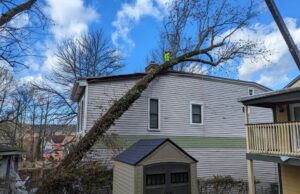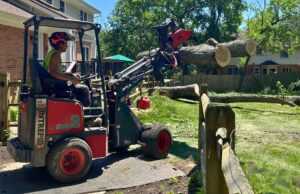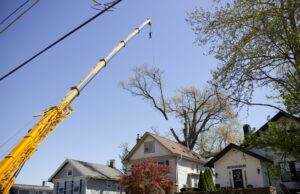As winter fades, both Cincinnati residents and the trees that line our yards and streets welcome the melting snow, rising temperatures, and return of sunshine. After heavy snow and ice storms hammered the Midwest in early 2025, our trees need special attention to recover from winter stress.
Now that the snow is melting and hints of green are returning to your yard, it’s time to prepare your trees for the growing season ahead. Investing in tree care now ensures you get to enjoy the most your trees have to offer this year. Here’s what you need to know about spring tree care in the Cincinnati area.
Key Takeaways:
- Simple spring inspections can help you catch issues early, especially after winter storm damage.
- Proper pruning of winter-damaged branches helps trees heal quickly and reduces the risk of future storm damage in spring and summer.
- Mulching in spring helps retain soil moisture and provides essential nutrients for healthy growth.
- The right combination of watering, fertilizing, and preventive care in spring sets trees up for success all year long.
Why Spring Tree Care Matters So Much in Cincinnati
Many property owners across Southwest Ohio understand the importance of pre-winter tree care – pruning to prevent storm damage, removing dead trees before they fall, and mulching to help insulate tree roots. But many homeowners wonder why they need to care for their trees in spring. Don’t most trees just seem to bounce back to life on their own?
Most trees, yes, but some might need support to help them recover from the stress and damage caused by a violent winter.
After winter snow and ice storms, trees might have:
- Hidden cracks and splits from freezing temperatures
- Broken or damaged branches beneath heavy snow loads
- Weakened root systems from ground freeze thaw cycles
- Salt damage from winter road treatments
- Frost damage to tender bark and buds
- Sunscald, especially on younger trees
Spring tree care helps to address these issues now, so they can enter the growing season without unnecessary stress. Spring tree care also sets your trees up for success through the rest of the year by:
- Supporting strong new growth and leaf development
- Preventing pest infestations as insects become active
- Hydrating and preparing trees for summer heat and drought
- Identifying and treating disease before it spreads
- Correcting structural issues before the summer storm season
Investing time in spring tree care now prevents expensive problems later. Plus, healthy trees generally look more beautiful. They’re safer, provide more shade, and help reduce cooling costs. But trees need the extra love and care to be their best.
1. Check Your Trees for Winter Damage
The first step in spring tree care is a thorough inspection of your trees, especially after Cincinnati’s harsh winter storms and before foliage starts to hide potential issues. Start by walking around each tree and examining it from all angles. Look up into the canopy and down at the root zone, keeping an eye out for any changes since fall.
Winter damage often shows up as:
- Cracked or peeling bark, especially on the south side of the trunk
- Split branch unions where heavy snow and ice collected
- Browning or discolored areas on evergreen needles
- Exposed roots from soil erosion during freeze thaw cycles
- Leaning trunks from soil movement or root damage
Property owners should pay special attention to any trees near buildings, driveways, or power lines, as problems with these trees could become hazardous. Document any issues with photos and notes so you can track changes over time, and have a tree care professional inspect any questionable trees.

Trim broken branches, especially those near the house.
2. Trim Dead and Damaged Branches
If you notice any dead, broken, or hanging branches, now’s the time to get them professionally pruned. These can fall at any time, making them a serious safety hazard. And if they break off, they’ll likely cause a large wound, which can create unnecessary stress for the tree.
Wounds also attract pests and diseases, so making clean cuts to remove weak branches is much better than letting nature run its course.
A light spring pruning can benefit trees and your property by:
- Removing potential hazards before spring storms hit
- Allowing trees to direct energy toward healthy growth
- Making clean cuts that heal properly and quickly
- Reducing the risk of pest infestation or fungal diseases from entering through broken branches
- Improving overall tree structure and appearance
While small branches on smaller trees can be a DIY project for many homeowners, larger limbs or anything requiring a ladder should be left to professionals.
If pruning small branches yourself, always cut back to healthy wood, making clean cuts just outside the branch collar. Avoid leaving stubs or making flush cuts against the trunk, as these create entry points for insects and disease. And make sure you use clean, well-maintained tools and all the appropriate safety equipment.
3. Add Fresh Mulch Around Your Trees
Proper mulching is one of the best things you can do for your trees in spring. A fresh layer of organic mulch helps retain soil moisture, regulate soil temperature, and slowly release nutrients as it decomposes over time.
Just make sure to:
- Use organic materials like wood chips, shredded bark, or leaf mulch.
- Apply mulch 2 to 4 inches deep in a circle around the tree.
- Extend the mulch ring to the tree’s drip line, when possible, to cover the majority of the tree’s root system.
- Keep mulch 2 to 3 inches away from the trunk to prevent rot.
- Break up old, compacted mulch before adding new material.
Avoid the common mistake of piling mulch against the tree trunk in a “volcano” shape. This harmful practice traps moisture against the bark and can lead to decay, pest problems, and root issues.
4. Water Your Trees After Winter
Most Cincinnati property owners don’t think about watering trees in spring, especially with our typical spring rainfall. But after a long winter, your trees need consistent moisture to support new growth and recover from winter stress.
Check soil moisture by inserting a long screwdriver into the ground near your trees. If it goes in easily, soil moisture is good. If you meet resistance, your tree might need water. Focus watering on:
- Young trees planted in the last 3 years
- Trees in sandy or fast draining soils
- Areas under thick evergreen canopies that block rainfall
- Trees showing signs of drought stress from winter
- South and west facing trees that get more sun exposure
When watering, apply moisture slowly and deeply rather than frequent light sprinklings. This encourages the development of a denser root system. If spring brings heavy rains, hold off on additional watering until the soil begins to dry.
5. Feed Your Trees
Early spring is the perfect time to fertilize trees in Cincinnati, right as they begin their main growth phase for the year. But not every tree needs fertilizer. Many homeowners make the mistake of applying fertilizer to all their trees, regardless of the tree’s condition or the soil content. But adding fertilizer without knowing what your soil needs can do more harm than good.
Before applying any nutrients, look for signs that your tree might need a boost:
- Pale or yellowing leaves
- Smaller than normal leaf size
- Poor annual growth
- Sparse canopy
- Dead branches in the crown
Consider testing the soil in your yard in multiple places to see if nutrient deficiencies exist. If so, apply an appropriate fertilizer, giving trees what they are currently lacking. Testing soil sounds intimidating, but you can often get simple test kits at your local hardware store, garden center, or online. This is one of the most valuable things you can do if you love your trees and your landscape as a whole.
6. Plant New Trees
Fall and spring are the best times to plant new trees in Ohio. So, if you’re looking to fill some gaps in your landscape, now’s a great time to do it.
During spring in Cincinnati, the soil is workable, temperatures are mild, and regular rainfall helps establish strong root systems before summer heat arrives. Plus, local nurseries typically stock the best selection of trees in spring.
When selecting new trees for your property, consider:
- The mature size of the tree and available space
- Overhead power lines or underground utilities
- Soil conditions and drainage in your planting location
- Sun exposure throughout the day
- Native species that thrive in Cincinnati’s climate
For the best results, plant trees as soon as the ground can be worked in spring. Dig a hole twice as wide as the root ball but no deeper than the root flare. Remove any circling roots, position the tree at the proper height, and backfill with existing soil. Water thoroughly and add mulch, keeping it away from the trunk.
FAQs About Spring Tree Care in Cincinnati
Will spring pruning harm my trees?
Technically, pruning any time of the year will harm trees. But when done by professionals, wounds are minimized and able to heal rather quickly. While late fall and winter are a great time for heavier pruning jobs, where much of the canopy is removed, spring is a good time to remove winter storm damage.
When should I fertilize my trees in spring?
Wait until the ground has thawed completely and soil temperatures reach about 55 degrees Fahrenheit. In Cincinnati, this usually occurs in late March or early April. Fertilizing too early can stimulate growth before the last frost has passed, which can damage your trees.
What should I do if my tree was damaged by winter storms?
Document the damage with photos and have a Certified Arborist inspect the tree as soon as possible. And don’t wait until spring – call a tree care professional immediately, even in winter, if trees are severely damaged.
How often should I water newly planted trees?
During the first growing season, water new trees deeply once or twice a week, depending on rainfall. Check soil moisture regularly by inserting a screwdriver into the ground. If it meets resistance, your tree needs water. Water deeply and slowly, preferably with drip irrigation or a soaker hose.
Give Your Trees the Best Start this Spring with Professional Care from Lefke Tree Experts
Spring is the season for fresh starts – so why not give your trees the care they deserve? A little attention now can mean stronger growth, healthier branches, and fewer headaches later in the year. Whether you need pruning, removal, or expert advice, Lefke Tree Experts has you covered.
Call us at 513-325-1783 or fill out our online form to request an estimate to schedule your spring tree care today!









